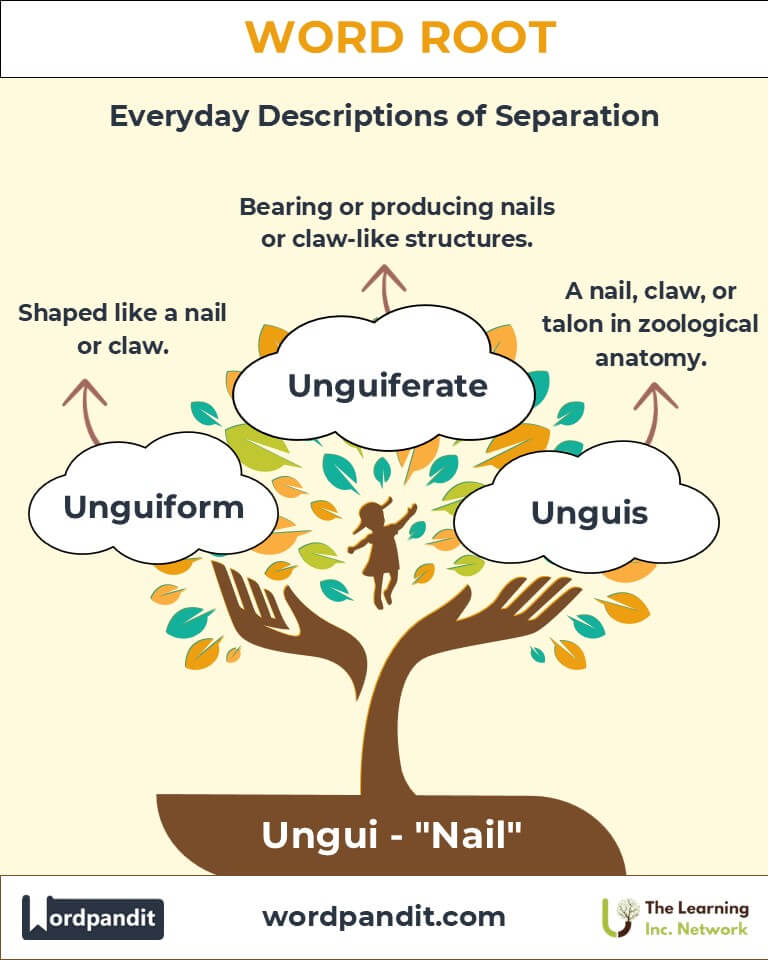Ungui: The Nail in Language and Science
Discover: The fascinating world of the root "ungui," derived from Latin, meaning "nail." From describing the claws of animals to intricate botanical structures, "ungui" serves as a cornerstone in fields such as biology, zoology, and more. This article explores the depth and versatility of this root in science and everyday language.

Table of Contents
- Introduction: The Essence of "Ungui"
- Etymology and Historical Journey
- Mnemonic: Unlocking the Power of "Ungui"
- Common "Ungui"-Related Terms
- "Ungui" Through Time
- "Ungui" in Specialized Fields
- Illustrative Story: "Ungui" in Action
- Cultural Significance of "Ungui"
- The "Ungui" Family Tree
- FAQs about the "Ungui" Word Root
- Test Your Knowledge: "Ungui" Word Root Quiz
- Conclusion: The Living Legacy of "Ungui"
1. Introduction: The Essence of "Ungui"
What connects the claws of a tiger, the delicate petals of a flower, and the nails on our fingertips? The answer lies in the root "ungui," pronounced "uhn-gwee," meaning "nail" in Latin. This versatile root manifests in biology, botany, and zoology, capturing the essence of structures resembling nails or claws.

2. Etymology and Historical Journey
The root "ungui" traces its origin to the Latin word unguis, meaning nail, claw, or talon. Ancient Romans used it to describe not only human nails but also the claws of animals and hooked botanical structures. Over time, "ungui" expanded into scientific terminologies, retaining its visual and functional connotations.
3. Mnemonic: Unlocking the Power of "Ungui"
Imagine an elegant tiger raising its paw to display sharp, curved claws. Now, picture those claws etched with the word "UNGUI," symbolizing its Latin meaning.
Mnemonic Device: "Ungui: The root that hooks into claws, nails, and beyond!"
4. Common "Ungui"-Related Terms
- Unguiculate (uhn-gwik-yuh-lut): Having claws or nails.
Example: "Cats are unguiculate mammals, relying on their retractable claws for hunting." - Unguiferate (uhn-gwif-er-it): Bearing or producing nails or claw-like structures.
Example: "The unguiferate appendages of certain insects are critical for climbing." - Ungual (uhn-gwuhl): Relating to the nails or claws.
Example: "The ungual bone supports the claw structure in birds." - Unguiform (uhn-gwee-form): Shaped like a nail or claw.
Example: "The petals of the flower were unguiform, curving gracefully." - Unguis (uhn-gwis): A term for a nail, claw, or talon in zoological anatomy.
Example: "The unguis of the hawk is adapted for gripping its prey."
5. "Ungui" Through Time
- Ungula (Latin): Initially used to describe the hoof of an animal, later adapted to describe claw-like or nail-like structures.
- Modern Adaptation: Words like "unguiculate" became standard in zoological descriptions, highlighting evolutionary traits.
6. "Ungui" in Specialized Fields
- Zoology:
- Unguiculate: Refers to animals with distinct claws or nails, such as primates or felines.
- Botany:
- Unguiform Structures: Petals or sepals resembling claws, aiding in pollination.
- Medicine:
- Ungual Disorders: Conditions affecting nails, such as fungal infections.
7. Illustrative Story: "Ungui" in Action
Dr. Elena, a botanist, was fascinated by the unguiform petals of a rare orchid species. These claw-like structures helped the flower trap specific pollinators. Meanwhile, her zoologist friend, Raj, studied unguiculate mammals, comparing the claws of tigers and leopards. Together, they discovered a link between plant and animal adaptations, showcasing the root "ungui" as a bridge between disciplines.
8. Cultural Significance of "Ungui"
Throughout history, claws and nails have symbolized power and beauty. From the decorative nails of ancient Chinese royalty to the fierce talons in mythological creatures, "ungui" reflects humanity’s fascination with these small but mighty structures.

9. The "Ungui" Family Tree
- Onycho (Greek: claw or nail):
Example: Onychomycosis: A fungal infection of the nails. - Clav (Latin: key, but also nail-like):
Example: Clavicle: The collarbone, resembling a small key. - Ungul (Latin: hoof):
Example: Ungulate: Hoofed mammals like deer and horses.
10. FAQs About " Ungui "
.Q: What does the root "Ungui" mean?
A: The root "Ungui" is derived from the Latin word unguis, meaning "nail" or "claw." It is often used in scientific terminology to refer to structures resembling claws, nails, or similar formations.
Q: How is "Ungui" used in anatomy?
A: In anatomy, "Ungui" appears in terms like "ungual," which refers to things related to nails or claws, such as ungual phalanges, the bones at the tips of fingers or toes that support nails or claws.
Q: What is an ungulate?
A: Ungulates are hoofed mammals whose hooves are specialized structures derived from claws. Examples include horses, deer, and cattle.
Q: Can "Ungui" be used metaphorically?
A: Yes, metaphorically, "Ungui" can describe something sharp or grasping, much like the function of claws in the animal kingdom.
11. Test Your Knowledge: " Ungui " Mastery Quiz
1. What does the root "Ungui" signify?
2. What are ungulates?
3. What does "ungual" refer to in anatomy?
4. How can "Ungui" be used metaphorically?
5. What are examples of ungulates?
12. Conclusion: The Living Legacy of "Ungui"
The root "ungui" highlights the intricate beauty of nails and claws in nature. From human anatomy to the adaptations of animals and plants, it bridges disciplines and enriches our vocabulary. As science and language evolve, "ungui" continues to symbolize strength, precision, and functionality in both biology and culture.












